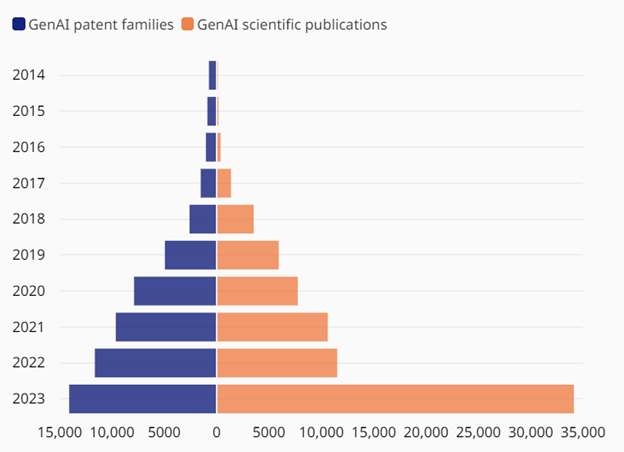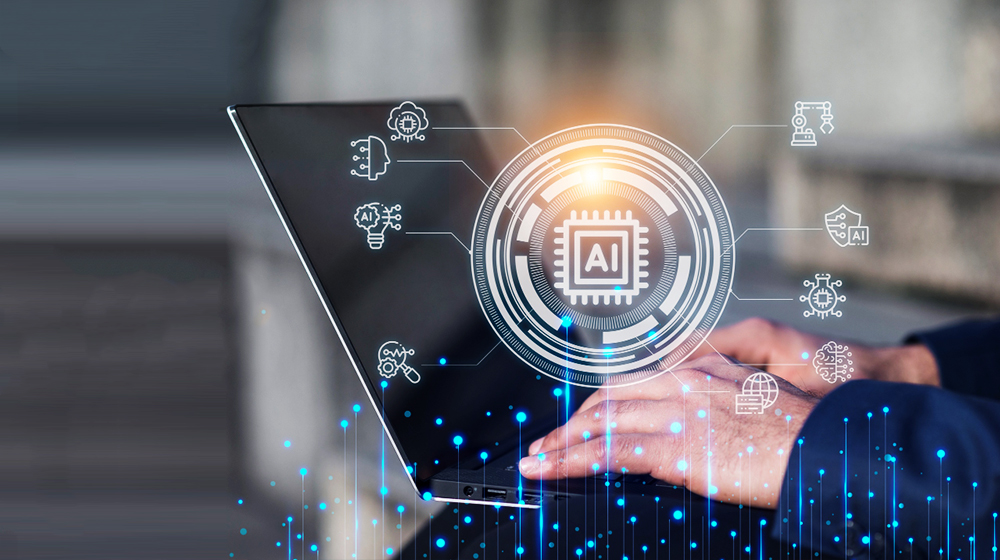Exploring the Global Landscape of GenAI Patents
What is GenAI?
Generative AI (GenAI) is not just another buzzword in the tech industry—it’s the engine behind a new era of creativity and innovation. Imagine machines that can compose symphonies, design fashion lines, craft cinematic visuals, and even pioneer new drug formulations—all autonomously. This is the reality GenAI is shaping, pushing the boundaries of what’s possible in sectors as diverse as entertainment, healthcare, and manufacturing.
As we stand on the brink of this technological revolution, the implications are vast and profound, promising to redefine how we create, interact, and innovate in the years to come.
Key Factors and Growth
The rapid advancement of GenAI over the past decade can be attributed to three primary factors:
- the availability of powerful computing resources,
- vast datasets for training, and
- improved AI and machine learning algorithms.
One of the most pivotal developments in this space has been the introduction of transformer architectures in Large Language Models (LLMs) like GPT. These advancements have catalyzed the growth of GenAI applications across various domains, from healthcare to manufacturing.
This technological evolution is mirrored in the exponential increase in patent filings related to GenAI. In 2014, there were only 733 patent families focused on GenAI; by 2023, this number had surged to over 14,000—a staggering 800% increase since the introduction of transformers in 2017.
Similarly, the volume of scientific publications in this field has grown from just 116 in 2014 to more than 34,000 in 2023, underscoring the global academic and industrial focus on GenAI.

Source: WIPO
Leading Institutions in GenAI Research and Innovation
The Chinese Academy of Sciences leads the charge in GenAI research, with over 1,100 scientific publications since 2010. Tsinghua University and Stanford University follow closely, each contributing more than 600 publications.
Notably, Alphabet/Google is the only company to feature in the top 20 institutions for GenAI publications, reflecting its significant investment in AI research.
However, when citations measure impact, companies dominate the landscape. Alphabet/Google stands out as the leading institution, with other tech giants like OpenAI also making a substantial impact despite a smaller volume of publications.
OpenAI, for example, has only published 48 papers but has garnered over 11,800 citations, reflecting the high impact and relevance of its research.
Patent Filings
In the race for GenAI patents, Chinese companies are leading the charge. Tencent, Ping An Insurance Group, and Baidu hold the most GenAI patents, leveraging their innovations in areas like chatbots, risk assessment, and AI-driven customer experiences. Tencent, for instance, is integrating GenAI capabilities into products like WeChat, while Ping An focuses on GenAI models for underwriting and risk assessment.
U.S. companies like IBM, Alphabet/Google, and Microsoft are also key players in the GenAI patent race. IBM’s GenAI platform, watsonx, is designed to deploy and customize LLMs with an emphasis on data security and compliance. Alphabet/Google’s AI division DeepMind has been steadily integrating GenAI into its suite of products and services, enhancing user experiences across the board.
Top Organizations by GenAI patents
|
Company |
Headquarters |
#GenAI Total Patents |
|
Tencent |
China |
2,074 |
|
Ping An |
China |
1,564 |
|
Baidu |
China |
1,234 |
|
IBM |
USA |
601 |
|
Alibaba |
China |
571 |
|
Samsung |
South Korea |
468 |
|
Alphabet |
USA |
443 |
|
ByteDance |
China |
418 |
|
BBK Electronics |
China |
377 |
|
Microsoft |
USA |
377 |
|
NetEase |
China |
337 |
|
NTT |
Japan |
330 |
|
Huawei |
China |
328 |
|
China Mobile |
China |
300 |
|
State Grid Corporation of China |
China |
291 |
|
Adobe |
USA |
257 |
|
Sony |
Japan |
218 |
|
Siemens |
Germany |
208 |
|
Ant Group |
China |
202 |
|
ICBC |
China |
191 |
Source: WIPO, April 2024
Geographical Hotspots for GenAI Innovation
China has emerged as the global leader in GenAI innovation, responsible for more than 38,000 patent families between 2014 and 2023. Since 2017, China has consistently published more GenAI patents each year than all other countries combined. The United States ranks second, with approximately 6,300 patent families during the same period.
Other key players include South Korea, Japan, and India, all of which are among the top five countries for GenAI patenting. The United Kingdom leads in Europe, followed closely by Germany.
Together, these countries account for 94% of global GenAI patenting activity, highlighting their dominance in this rapidly evolving field.
What are the main types of data used in GenAI patents?
- Image
- Video
- Text
- Speech
- Sound
- Music
GenAI encompasses a wide range of technologies, each with unique applications and strengths:
- Generative Adversarial Networks (GANs): These models use a generator to create data and a discriminator to evaluate it, refining the output with each iteration. GANs are particularly valuable in image generation, style transfer, and data augmentation.
- Variational Autoencoders (VAEs): VAEs encode data into a latent space and decode it back, enabling the generation of new data by sampling the latent space. They are widely used in image generation, anomaly detection, and semi-supervised learning.
- Decoder-based Large Language Models (LLMs): LLMs, such as GPT, excel in text generation, completion, translation, and summarization, leveraging transformer architectures and vast amounts of pre-training data.
Application Areas
GenAI is poised to transform numerous industries, with significant implications for content creation, productivity, and innovation:
- Life Sciences: GenAI accelerates drug development by screening and designing molecules for new formulations and personalized medicine.
- Document Management: Automation of tasks like document creation, editing, and management saves time and resources while enhancing accuracy.
- Business Solutions: GenAI powers customer service chatbots, retail assistance systems, and employee knowledge retrieval, streamlining operations.
- Industry and Manufacturing: GenAI enables digital twin programming, product design optimization, and predictive maintenance, driving efficiency and innovation.
- Transportation: Autonomous driving and public transportation optimization are key areas where GenAI is making a significant impact.
The Future of GenAI
GenAI is not just a technological trend; it is a fundamental shift in how we approach innovation across industries. As countries like China and the United States lead the way in patenting and research, the global landscape of GenAI continues to evolve rapidly. With applications ranging from healthcare to manufacturing, GenAI is set to become a cornerstone of technological progress in the coming years.
For companies and researchers, staying ahead in the GenAI race requires understanding the technology and actively engaging in patenting and publication activities. The future of GenAI is bright, and those who invest in this field today will shape the innovations of tomorrow.
LegalAdvantage is well-equipped to handle all IP matters related to GenAI, offering expert guidance and comprehensive support to protect and advance your innovations in this cutting-edge field.


